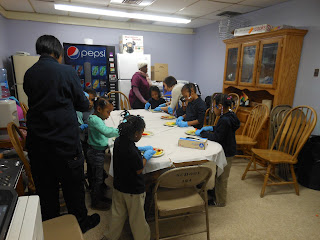In one book -- Berry Tales -- Goldilocks ate Pappa Bear's cold oatmeal, ate Mamma Bear's (browned) bananas and drank Baby Bear's warm milk -- all of which had been left sitting on the table for 3-4 hours. As expected Goldilocks got food borne illness (food poisoning). With a little twist to the story -- the 3 bears took care of Goldilokcs until she got well. For the children this story represents one more way to reinforce the need for proper food safety including hand washing, and proper food storage. As much as the children enjoy the books -- their favorite part is the "cooking" portion of the class.
This week we made cold whole wheat pasta salad with raw vegetables and low fat salad dressing. As the food items for our cold pasta salad were introduced -- one child said -- "Ugh mushrooms - they are nasty" - but still agreed to help cut up the carrots and mushrooms (the hardest ones to cut with our plastic knives).
We then mixed all of this into our cold whole wheat pasta. Amazing the child who said "ugh" to the mushrooms -- ate two servings of the pasta salad he helped to make and then wanted to take some home to show his family. Finally during the class we reviewed how the Baltimore Ravens (soon to be Superbowl Champions) had changed their diet starting with 2012 practice; they replaced white bread, white rice and white pasta with whole wheat and reduced fat versions and picked healthier food options. Read this article for more information. So like the Baltimore Ravens -- we want to eat healthier to be more successful in our activities.
Posted on behalf of Phyllis McShane






.JPG)
